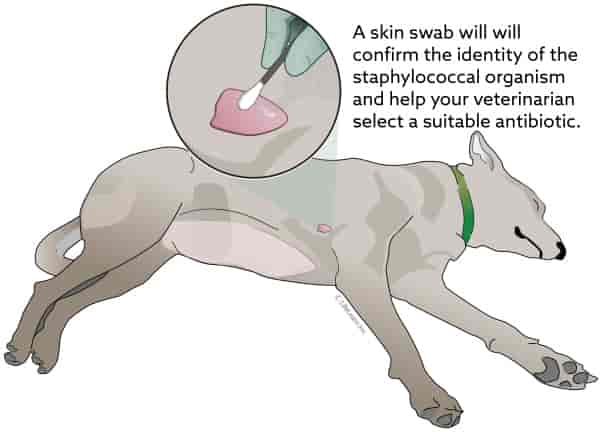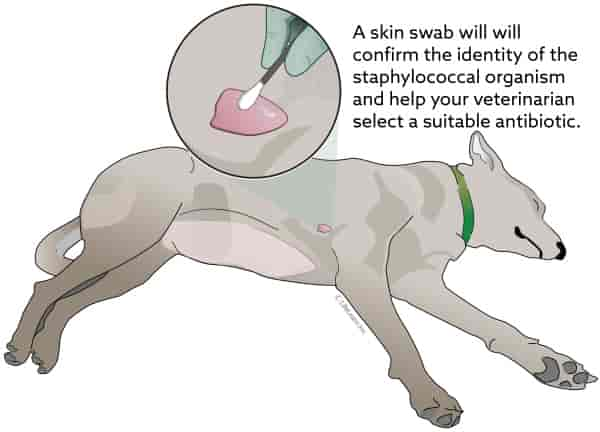Staphylococcal Dermatitis: A Sneaky Skin Condition
Staph dermatitis, or Staphylococcal pyoderma, is an irritating skin condition caused by a group of bacteria known as Staphylococcus. These bacteria typically reside on the skin without causing any problems. However, when the skin becomes irritated, scratched, or exposed to certain allergens, these bacteria can invade and cause an infection. The result? Inflamed and itchy skin that can be quite uncomfortable for your furry friend.
The Culprits: Scratching and Irritation
Scratching, licking, and chewing are common causes of skin irritation in dogs. Disorders that cause itching or changes in the skin’s environment create ideal conditions for Staphylococcus to thrive. Fleas, allergies (both inhalant/seasonal and food allergies), seborrhea, hormonal imbalances, and irritating chemicals can all contribute to skin irritation and make your dog susceptible to staphylococcal dermatitis.
Diagnosing the Condition
Identifying staphylococcal dermatitis can sometimes be challenging. There are two typical skin lesions associated with this condition. One type appears as a red area with a pimple-like pustule in the center, while the other type is a circular, reddish area with a crusty edge and hair loss in the center. These skin patterns, accompanied by itching, are highly suggestive of staphylococcal dermatitis. Confirming the diagnosis usually involves a skin swab or biopsy to identify the bacteria and determine the most suitable antibiotic treatment.
Treating Staphylococcal Dermatitis
Treating staphylococcal dermatitis involves a two-pronged approach. First, antibiotics are typically prescribed to eliminate the bacterial infection. Antibacterial shampoos, sprays, and spot-on treatments can also help control the infection. Secondly, it’s essential to address the underlying cause of itching and scratching. Your dog may require additional tests to identify specific allergies or conditions contributing to the itching.
Is It Contagious?
Rest assured, staphylococcal dermatitis is not contagious to you or other pets. Staphylococcus bacteria naturally reside on the skin of all dogs, cats, and humans. Infection only occurs when the skin is damaged or there is an underlying medical condition.
Staphylococcal Hypersensitivity: A Recurring Nightmare
Sometimes, dogs develop an allergic reaction to the staphylococcal bacteria, leading to a condition called Staphylococcus hypersensitivity or Staphylococcus allergy. The symptoms and skin lesions caused by hypersensitivity are identical to those of staphylococcal dermatitis. However, the key difference lies in recurrence. If dermatitis is treated effectively, the bacterial infection is eliminated, and the itching stops. On the other hand, if a dog with staphylococcal hypersensitivity is treated, the skin lesions often return shortly after treatment.
Treating Staphylococcal Hypersensitivity
Treating staphylococcal hypersensitivity follows a similar path as staphylococcal dermatitis. Oral antibiotics, medicated shampoos, and anti-itch treatments are commonly recommended. However, long-term control for hypersensitivity may involve periodic routine injections of staphylococcal bacterin. These injections aim to reprogram the immune system’s response to the bacteria, reducing the overreaction that leads to hypersensitivity. With this treatment, significant improvement is often observed, even in cases where other treatments have failed.
A Promising Solution
Staphylococcal bacterin desensitization is successful in a majority of cases, with up to 77% of dogs responding well to the treatment. Dogs typically receive routine injections for one to two years, followed by less frequent injections to maintain control over the condition. In cases where desensitization fails, periodic antibiotic treatments and medicated baths may be necessary. However, it’s important to note that prolonged antibiotic use may lead to bacterial resistance, requiring changes in the treatment approach.
If your dog is diagnosed with staphylococcal dermatitis or hypersensitivity, follow your veterinarian’s instructions carefully. Stick to the prescribed antibiotics, medicated baths, and treatments to ensure successful management of the condition. With proper care and treatment, your dog can find relief and restore healthy, itch-free skin.



